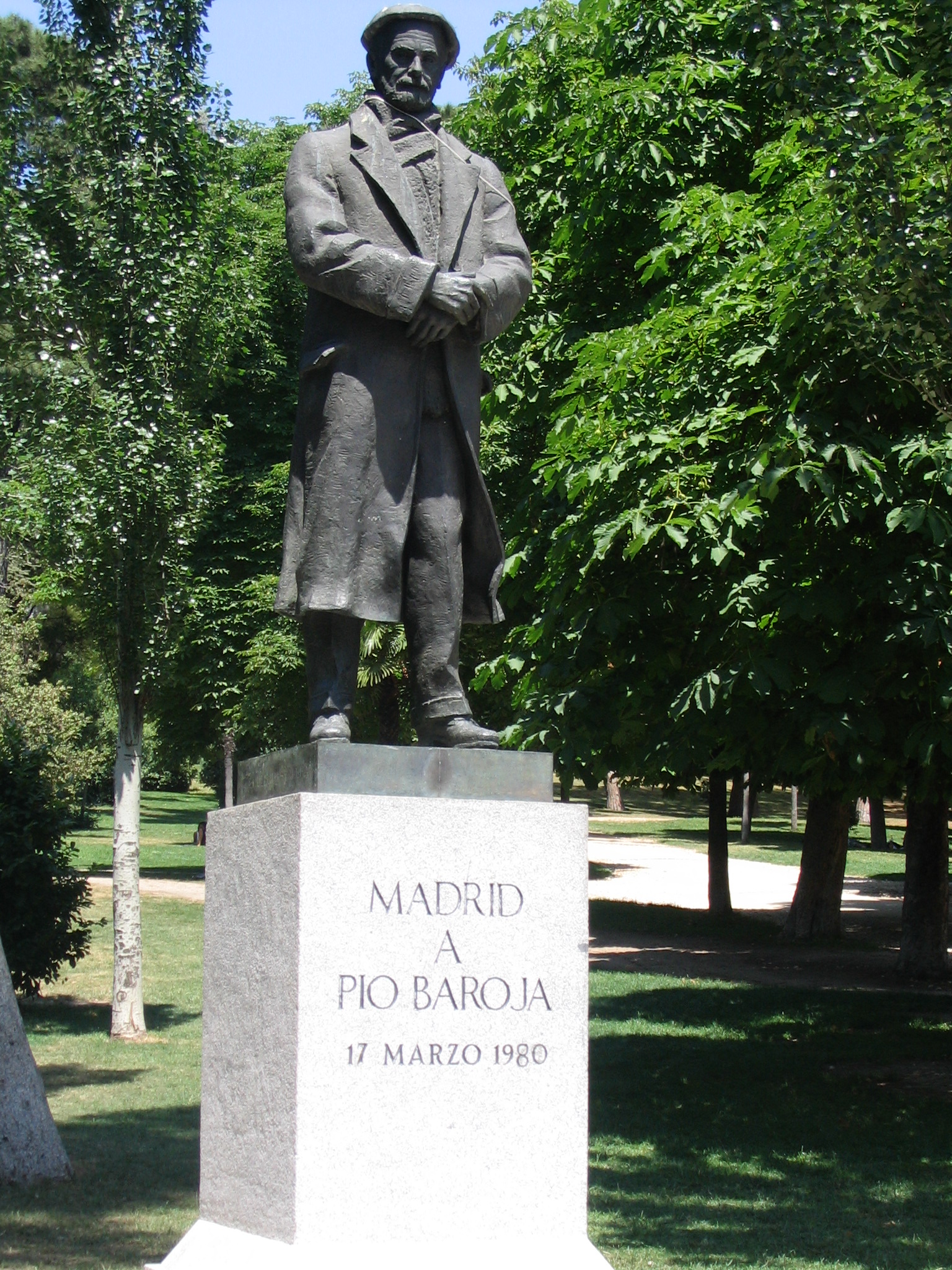- Pío Baroja
Infobox writer
name = Pío Baroja
caption = Pío Baroja
imagesize = 250px
caption = Statue of Pío Baroja in Retiro Park, Madrid
birth_date = birth date|1872|12|28|mf=y
birth_place =San Sebastián
nationality = Spanish
death_date = death date and age| 1956|10|30|1872|12|28
death_place =Madrid, Spain
occupation =Author ,Novelist ,Biographer ,Physician
genre =
movement =Generation of '98
spouse =
children =
influences =
influenced =John dos Passos ,Ernest Hemingway ,Julio Caro Baroja Pío Baroja y Nessi (
December 28 ,1872 –October 30 ,1956 ) was a Spanish Basque writer, one of the key novelists of theGeneration of '98 . He was a member of an illustrious family, one of his relatives was a painter and engraver, and his nephewJulio Caro Baroja was a well known anthropologist.He was born in
San Sebastian, Spain . Although educated as a physician, Baroja only practised this trade briefly. As a matter of fact, he would use his student's memories - some of them he would consider terrible - as the raw material for his novel "The Tree of Knowledge". He also managed the family bakery for a short time and ran unsuccessfully on two occasions for a seat at the Cortes (Spanish parliament) as a Radical Republican. Baroja's true calling, however, was always writing, which he began seriously at the age of 13.His first novel was "La Casa de Aizgorri" ("The House of Aizgorri", 1900), which is part of a trilogy called "La Tierra Vasca" ("The Basque Country", 1900–1909). This trilogy also includes "El Mayorazgo de Labraz" ("The Lord of Labraz", 1903) which became one of his most popular novels in Spain. However, he is best known internationally by another trilogy entitled "La Lucha por La Vida" ("The Struggle for Life", 1922–1924) which offers a vivid depiction of life in Madrid's slums.
John Dos Passos greatly admired these works and wrote about them. Another major work, "Memorias de un Hombre de Acción" ("Memories of a Man of Action", 1913–1931), offer a depiction of one of his ancestors who lived in the Basque region during theCarlist uprising in the 19th century. Another of his trilogies is called La mar ("The sea") and comprises La estrella del capitán Tximista, Los Pilotos de Altura y Los mercaderes de esclavos. Baroja also wrote the biography of Juan Manuel Antonio Julian Van Halen, a mariner who lived in the late XVIII century. However, some believe his masterpiece to be "El árbol de la ciencia" (1911) (translated as "The Tree of Knowledge "), a pessimisticBildungsroman that depicts the futility of the pursuit of knowledge and of life in general. The title is ironically symbolic: The more the chief protagonist Andres Hurtado learns about and experiences life, the more pessimistic he feels and the more futile his life seems.In keeping with Spanish literary tradition, Baroja often wrote in a pessimistic, picaresque style. His deft portrayal of the characters and settings brought the Basque region to life much as
Benito Pérez Galdós ' works offered an insight into Madrid. Baroja's works were often lively, but could be lacking in plot, and are written in an abrupt, vivid, yet impersonal style. Sometimes he is even accused of grammatical errors, which he never denied.Baroja as a young man believed loosely in anarchistic ideals, as other members of the '98 Generation. However, later he would derive into a simple admiration of men of action, somehow similar to Nietzshe's overman. His vitalistic vision of life - although pessimistic - led his novels, his ideas and his figure to be considered somehow a precursor of a kind of Spanish fascism. In any case, he was not loved by catholic and traditionalist ideologists, and his life was at risk during the Spanish Civil War (1936-39).
Ernest Hemingway was greatly influenced by Baroja, although this is not fully appreciated by English-speaking critics.Works available in English
*"
The Tree of Knowledge " (1974). Howard Fertig: ISBN 0865273162
*"Zalacain the Adventurer" (1998). Lost Coast Press: ISBN 1882897137
*"Caesar or Nothing" (1976). Howard Fertig: ISBN 0865272247
*"Youth And Egolatry" (2004). Kessinger Publishing: ISBN 1419195409ources
* [http://www.bookrags.com/P%C3%ADo_Baroja "BookRags"]
External links
*gutenberg author|id=P%C3%ADo_Baroja|name=Baroja
* [http://www.hrc.utexas.edu/research/fa/baroja.html Pio Baroja Collection] at theHarry Ransom Center at theUniversity of Texas at Austin
Wikimedia Foundation. 2010.
